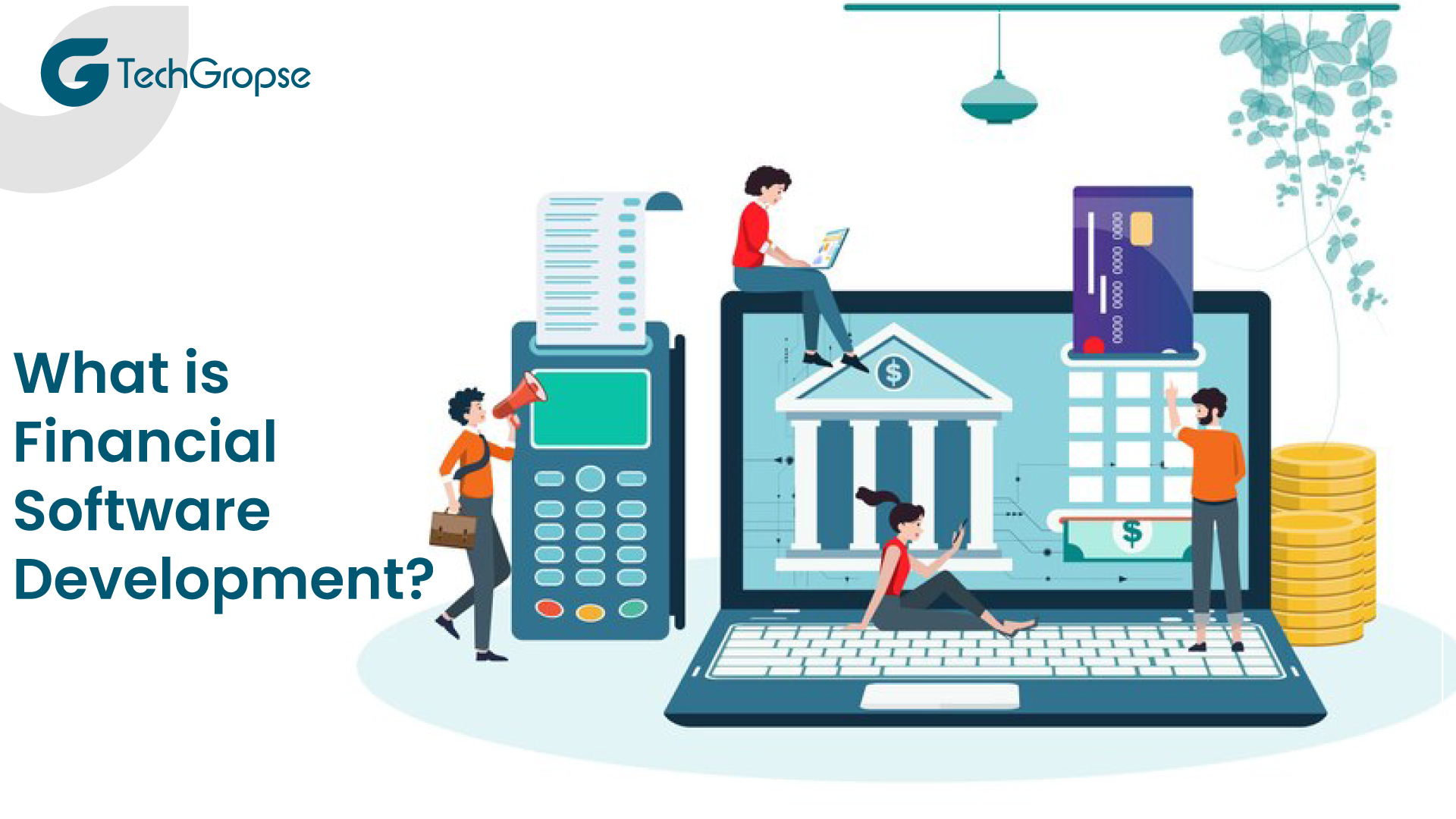As we know, 2022 was a big year for Fintech. Even big companies like Amazon, Walmart, Ikea, and Mercedes are using advanced computer programs to offer us all types of money stuff like banking, insurance, credit, and mortgages.
To build fintech software, you must stay up-to-date with the latest developments and implement advanced technologies that satisfy users’ requirements. Now we enter 2023, where tech leaders also want to jump into the Fintech world and capitalize on it to know everything about this evolving environment.
Fintech is the most dynamic and rapidly-evolving sector of the tech industry, with new technologies and trends constantly emerging. To stay ahead of the game, it is essential to prioritize user experience and security while utilizing the latest technology. Collaborating with a fintech software development company and focusing on mobile-first development will also be critical factors in creating successful fintech products.
Here, we will look at how to build fintech software in 2023, exploring the latest trends and technologies in the industry. We also cover fintech software development services and best practices for building secure, scalable, and user-centric fintech applications that deliver value to users.
What is Fintech?
Fintech refers to the innovative use of technology in the financial industry. It is a blend of finance and technology that aims to streamline and improve various financial services. Today most software development companies continuously focus to build fintech software.
Ranging from traditional banking services such as lending, payments, and investments to newer services like cryptocurrency trading and peer-to-peer lending. The exciting thing about Fintech is its ability to make financial services more accessible, affordable, efficient and secure for people across the globe.
Whether using mobile banking apps instead of visiting brick-and-mortar banks or investing in stocks via online platforms instead of hiring a traditional financial advisor. Now Fintech has changed the approach we interact with our money.
With rapid advancements in Artificial Intelligence (AI), blockchain technologies, and big data analytics, Fintech will continue revolutionizing the financial world in exciting ways!.
What is Financial Software Development?

Financial software development is the process of designing, building, and maintaining build fintech software that is used in the finance industry. Fintech software can range from easy financial calculators to complex trading platforms investment banks and funds use.
A fintech software development company aims to build applications that can help users manage their finances, make informed investment decisions, and minimize financial risk. One of the main advantages of financial software development is its ability to automate tasks once done manually.
For example, financial software can automate reconciling bank statements, tracking expenses, and creating financial reports. This saves time, decreases errors, and offers users more accurate and up-to-date financial information. Financial software can also help users analyze data and make more informed financial decisions.
A History of Fintech Software Development
The history of fintech development dates back many decades, with the first digital payment systems introduced in the 1950s. However, it was not until the 1990s that the term “fintech” began to describe integrating financial services with technology.
In the 2000s, the increase in smartphones and mobile technology sparked a new wave of fintech innovation. Mobile banking apps started to emerge, allowing customers to manage their finances on the go. This was accompanied by the development of mobile payment systems such as Apple Pay and Google Wallet.
As Fintech continues to evolve, it is likely to have a transformative effect on the financial industry, helping to improve the efficiency and accessibility of financial services worldwide.
Understanding the Fintech Landscape in 2023

The financial technology industry has been evolving in recent years, and this trend is expected to continue in 2023.
The industry has been driven by increasing consumer demand for digital financial services, the rise of modern technologies, and changing regulatory landscapes. Fintech is a great way for people to manage their finances, making it easier, faster, and more affordable.
It is split into regions like the Middle East, Asia Pacific, Africa, North America, and South America. At the end of 2030, it is expected to make a whopping $698.48 billion.
Some of the biggest Fintech things that people will be using from 2021 to 2030 are:
- Cryptocurrency-based solutions
- Wealth management
- Payments
- Insurance
- Personal Finance
- Trading solutions
- Money transferring
- Mortgage Solutions
1. Emerging Trends and Technologies in Fintech Industry
The emergence of 5G networks, artificial intelligence (AI), machine learning (ML), Blockchain, and cryptocurrency is expected to significantly impact the fintech industry in 2023. These technologies will allow more secure and efficient transactions, better risk management, improve customer experience and create new business models.
2. The Impact of COVID-19 on Fintech Industry
The COVID-19 pandemic has accelerated the shift towards digital financial services, as people are forced to avoid physical contact and use digital channels to conduct financial transactions. This trend will continue in 2023, with more people becoming comfortable with digital financial services.
Step to Step Guide to Build Fintech Software

Making a software product is a big deal, and it takes a lot of time and stuff. You must make it in more than one day.
So, to build fintech software, you must think of a good idea and a particular thing that makes you different. To make it easier, we made a list of five steps to follow when making a Fintech software product.
1. Project Requirements
It is essential to conduct a market analysis to select the future application and monetization model. First, establish the budget and timelines and pay close attention to the project evaluation.
2. Make a Design
If you plan to build fintech software systems, they should be simple to navigate and user-friendly. A simple interface gives impressive user experiences that are the most essential aspects. Find references, hire software developers, and work with a UI/UX team to make appealing designs.
3. Start Building the Software
Before build fintech software, define the features of your fintech software and the project’s scope. Describe and fix all issues quickly for users and how they would utilize the product. You can create a minimum viable product (MVP), a simple version of the software with all its essential features.
4. Test, Test, and Test
Testing is the essential process to build fintech software. Before launching, check and test the financial application software carefully. A test run will allow you to examine every area of the product’s functionality and observe any faults to prevent its future use.
5. Feedback and Reviews
Introduce the fintech software and gather initial user feedback. Real user input will help you highlight issues and suggest what features you should pass, eliminate, or modify.
If you want to build fintech software, you need expertise. A mobile app development company will be helpful to you whether you are a startup, have an outstanding concept, or need technical support.
Types of Fintech Software Development
Fintech, or financial technology, has been growing in the 21st century. As a result, various software types have emerged that have entirely transformed financial transactions and operations.
Let’s have a closer look at the primary types of financial software in use:
- Mobile Payment Applications: The first type of fintech software development is the Mobile Payment Applications, which offer customers a convenient and secure platform to send and receive money. These applications also use encryption and biometric security to protect users’ data and are widely used in e-commerce platforms to complete financial transactions.
- Blockchain-based solutions: Another type of fintech software development is the Blockchain-based solutions that provide secure, record-keeping systems for financial transactions. The Blockchain is a technology-based software operating in a decentralized, secure, transparent, decentralized network format. It is used to store data in blocks that are chained together, making it impossible to alter or hack the data.
- Artificial Intelligence (AI) and Machine Learning (ML) technology: AI is used to assess and enhance customer experience, while ML is used to expect future trends and customer behaviours. AI and ML analysis of past transactions and financial data has helped drive innovation in fintech software development.
An excellent example is the integration of chatbots in banking applications that enable customers to access financial information and customer service support 24/7.
- Insurance Technology Software: Did you know that insurance companies use incredible technology called InsurTech to help them do their job better? With this software, they can figure out how risky it is to insure someone or something, make better deals, and make it easier for people to sign up for insurance and get help when needed. You can even use apps to manage your life, car, home, and pet insurance.
- Personal Finance Management Software: Fintech is unique because it helps you monitor your money. With PFM apps, you can see how much money you make and spend. Additionally, it is easy to talk to the app and get help with your finances. All your money info is in one place, so it’s easy to see where your money is going.
- Digital Banking Software: With digital banking apps, you can manage your bank account and take advantage of all the financial services you need without going to the bank. You can open an account, get a loan, move money around, and make payments from your phone or computer. It is an experience like having a bank in your pocket.
- Investment Software: Investment software is excellent because it helps everyone invest their money, not just rich people. With an investment app, you don’t have to pay as much money to purchase and sell stocks, and you don’t have to go through various people to do it. It is like having a shortcut to making money.
- Tax Management Software: Tax management software is helpful for managing and filing taxes because taxes can be complicated. This unique software for businesses makes it easier to make, submit, and manage all the essential papers. It is so easy because everything is automatic, so you don’t need any experience or hire an accountant to help you.
Features to Build Fintech Software Systems
Financial technology, commonly known as Fintech, has transformed how we engage with excellent financial services. With the advance of fintech software systems, traditional banking has evolved to satisfy the demands of the digital age. However, to ensure that fintech software systems fulfil user expectations, they need to have certain features built-in, including:
1. Data visualization
Data visualization is becoming increasingly crucial for fintech software systems due to the vast amounts of data that financial institutions accumulate daily. As fintech companies continue to emerge, there is a need to simplify complex financial data sets and present them in ways that help clients make informed decisions.
Data visualization tools allow fintech companies to easily create dynamic dashboards and visual representations of data, providing an enhanced user experience.
2. Personalized User Experiences
Creating engaging and personalized user experiences is essential to build fintech software. You should hire dedicated developers who can use personalization, gamification, and social elements to create engaging experiences that keep users coming back. Personalization can also help users find the right financial products and services based on their preferences and goals.
3. Push Notifications
Push notifications are an essential piece of any modern fintech software system. With the ever-increasing amount of financial data available to consumers, they must get alerts in real-time to stay informed and make better decisions. In addition, notifications help to obtain this by offering timely updates on transactions, changes in account balances, and other critical financial events.
4. Secure sign-in
In today’s digital age, security is essential when it comes to build fintech software systems. Secure sign-in is a critical feature that ensures that only authorized individuals can access sensitive financial details. Two-factor authentication, biometric scans, and strong passwords are ways to implement secure sign-in. Encryption and data privacy policies are also vital for safeguarding financial records.
5. Multi-Platform Support
Multi-platform support has become essential in building fintech software systems. As the fintech industry continues to excite, companies must build fintech software systems accessible across various mobile, web, and desktop platforms. Cross-platform support enables fintech companies to reach a more extensive audience, increase customer engagement and offer a better user experience.
6. QR-codes
QR codes have become a famous tool in the fintech industry, providing a reliable and convenient means of data transfer between users and financial institutions. QR codes in fintech software systems have allowed for easy payment processing, online banking, and investment management, among other applications. This innovative technology has revolutionized how people conduct financial transactions, making them faster, more secure, and more accessible to a broader range of users.
Choosing the Right Technologies to Build Fintech Software
Choosing the right technologies for Fintech software development is one of the critical decisions businesses must make in today’s digital era. As Fintech applications often involve sensitive financial data, it is essential to use secure, scalable, and reliable technologies to deliver high performance.
Programming Language
Selecting the correct programming language and frameworks is crucial for fintech software development. Popular programming languages for Fintech include:
- Java
- Python
- Ruby
Framework
A framework for fintech software development is a set of tools, methodologies, and best practices that guide developers in building and delivering fintech applications.
- Spring
- Django
- Ruby on Rails
Database Technologies
Databases are used to store and manage transactional data and must provide high availability, data integrity, and scalability.
- MongoDB
- MySQL
- PostgreSQL
How Much Does Fintech Software Development Cost?
The fintech software cost can differ depending on multiple factors, such as the complexity of the software, the features needed, the size of the development team, and the location of the development team.
On average, the cost of fintech software development can range from about $50,000 to $500,000 or more. Small and medium-sized fintech companies may opt for offshore development teams to save costs, while larger companies may have their in-house development team.
Let’s go through some factors to have a basic idea about Fintech software cost:
| Type of Fintech Software | North America | Central/
Northern Europe |
Western Europe | Oceania | Asia |
| Lending Software | $240,000 | $140,000 | $160,000 | $210,000 | $86,000 |
| Investment Software | $210,000 | $130,000 | $160,000 | $190,000 | $90,000 |
| Banking Software | $360,000 | $180,000 | $250,000 | $320,000 | $120,000 |
| Insurance Software | $150,000 | $160,000 | $100,000 | $120,000 | $60,000 |
| Consumer Finance Software | $360,000 | $1500,000 | $260,000 | $320,000 | $110,000 |
*Remember that the prices mentioned in the above table are indefinite. The final cost of your project might differ as per your need and multiple factors.*
The Future of Fintech Software Development
Fintech companies must also be responsive to user feedback and change their software accordingly.
- Firstly, artificial intelligence (AI) and machine learning will become even more prevalent in the fintech industry in the future. These technologies have already been integrated into many fintech platforms, improving customer experience, risk management, fraud detection, and trading algorithms.
- Secondly, blockchain technology will continue to revolutionize the fintech industry. Blockchain’s decentralized nature makes it ideal for secure and transparent transactions, reducing the need for intermediaries.
- Thirdly, cloud-based solutions will become the norm in the fintech industry. Cloud technology provides an agile and scalable infrastructure that allows financial institutions to innovate quickly and reduce the time to market for new products and services.
- Fourthly, regulatory technology (Regtech) will continue to gain traction in the fintech industry. As financial institutions face stricter regulations, Regtech solutions are becoming increasingly popular. Regtech platforms provide automated compliance solutions, allowing financial institutions to reduce regulatory risks and costs.
- Lastly, open banking will also shape the future of the fintech industry. Open banking aims to enable financial institutions to share their data securely with third-party providers, allowing them to create new products and services.
The future of fintech software development is bright as the industry continues to multiply. Integrating AI and machine learning, as well as cloud-based solutions, blockchain technology, Regtech, and open banking, provides an opportunity for financial institutions to innovate and provide better service to their customers.
Example of Top 5 Fintech Software

The Fintech world is growing fast with many exciting apps that help people with money. These apps are so cool that they inspire banks and other money places to use technology to help people even more.
We picked the top 5 Fintech apps that are the best. We will tell you what they do, how they work, and how they can help you with your money. In addition, you can use them as examples to make your money app even better!
1. Finch
Finch is the best app for creating financial operations that are more accessible and more social. They are the most extensive user base of this Fintech product.
- Monitoring and management of expenses
- Group bill sharing
- Personal finance for users
- Financial and budget statistics
- Investment tracker
2. Chime
It is one of the fastest-growing digital banks that allow users to manage their expenses and savings significantly.
- Early payment receives
- Instant checking of deposits
- No monthly or other hidden fees
- No costs for sending funds
- Back mobile payment applications
3. Mint
Mint is a well-known app and popular for its high-end Fintech security solutions and valuable insights into the financial health of customers.
- Bill and balance management
- Personalized spending categories
- Budget and fund suggestions
- Multi-device sign-in options
- Net worth analysis of assets
4. Revolut
The following choice of Fintech software is Revolut. It combines finance management, payment, and banking services best.
- Access to travel insurance
- Bill and spending calculation
- Fixed monthly budget setting
- Multiple currency support
- Crypto trading and stocks
5. MoneyLion
Moneylion is a famous Fintech app that offers quick and easy loans, financial advice, wealth management tips, and more.
- Real-time notifications of transactions
- Direct deposit for APR cash advances
- Free credit score checking
- An instant transfer without fees
- Memberships for added benefits
Final Thought
Building fintech software in 2023 needs a deep understanding of the industry landscape, the latest technologies, and user needs.
By implementing the best practices outlined in this post, you can build fintech software that is both secure and scalable while providing an engaging and personalized user experience.
As the fintech industry continues to evolve, it will be essential to stay informed of new developments and modern trends and to continue to innovate and optimize fintech applications to meet the changing needs of users and the regulatory landscape.
FAQ: How to Build Fintech Software in 2023
1. How to build a fintech app
First, determine the problem that your app will solve and map out your user journey. Next, sketch a wireframe or prototype of your app design and create a list of necessary features.
2. How to create a fintech website
Creating a fintech website is an exhilarating endeavour that requires careful planning and execution. The first step is identifying the target audience, their needs, and what sets your fintech business apart from competitors.
3. What are some of the critical considerations for building secure fintech software?
Building secure fintech software requires several vital considerations, including identifying and mitigating security risks and threats, designing and implementing a secure architecture, and ensuring compliance with industry regulations and standards.
4. How can I ensure my fintech application meets regulatory requirements?
Compliance with regulatory requirements is critical for fintech applications, and there are several steps you can take to ensure your application meets these standards. This includes conducting thorough research on the relevant regulations and standards.

Hello All,
Aman Mishra has years of experience in the IT industry. His passion for helping people in all aspects of mobile app development. Therefore, He write several blogs that help the readers to get the appropriate information about mobile app development trends, technology, and many other aspects.In addition to providing mobile app development services in USA, he also provides maintenance & support services for businesses of all sizes. He tried to solve all their readers’ queries and ensure that the given information would be helpful for them.











